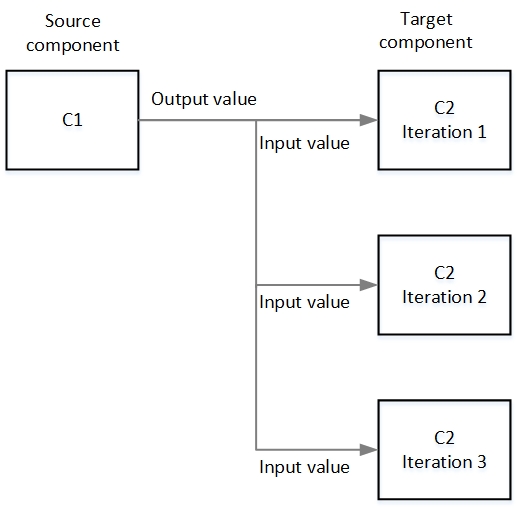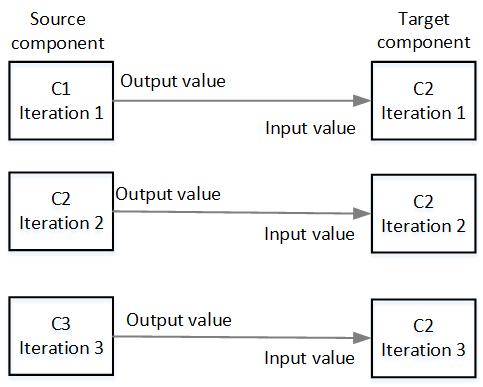Relevant for: business process testing
Parameter linkage enables you to pass data from test or flow parameters to component parameters, or between components. This tests the ability of your application to pass a value from one API to another in the course of the application's work.
The component or flow in which the output parameter is defined is the source. The component or flow that links to that output parameter is the target. In the example above, CreateLoan is the source component and SearchLoan is the target component.
Linking parameters when the component has iterations
As part of data driving a business process test, you can set components (or groups of components) to run multiple times in different iterations.
Linking can occur successfully only when UFT One can determine the target iteration for each source iteration. One of the following conditions must exist:
-
Condition 1. The source has one iteration and the target has one or more iterations (a "1–to–n" relationship).
-
Condition 2. The source and the target have the same number of iterations (an "n–to–n" relationship).
Note: When a source or target is a member of a group, the number of iterations is that of the group.
If the component iterations are not represented by a "1–to–n" or "n–to–n" relationship, a warning message is displayed.
When you use the output parameter of a previous component as the value for an input parameter of a subsequent component, the link between the output and input parameter applies to all component iterations of the input parameter. Likewise, when iterations of a source component in a business process test result in multiple output parameter values, the value that is provided by a given iteration run is passed as input to the corresponding iteration of the target component.
Parameter linking example
A business component,(named CreateLoan) has an output parameter that contains a generated loan ID. A subsequent business component, (named SearchLoan), can verify the loan if it has access to the CreateLoan loan ID value. This access is provided by linking the CreateLoan component output parameter to SearchLoan component input parameter.
For these examples, you create components corresponding to the different processes of your application for processing a customer loan request:
-
A component that tests the application's ability to receive the request, and generate a unique loan ID for the request (called CreateLoan).
-
A component that searches the existing loans to verify if the loan already exists (called SearchLoan).
-
A component that tests the loan request approval process (called ApproveLoan).

Linking Input and Output Parameters
When you create a business process test, you arrange the components in order to test the entire loan approval process workflow from receiving the request through approving the request.
The value of the LoanID output parameter is passed from the CreateLoan component to the SearchLoan component as the value of the LoanID input parameter for the component. The value is also passed to the ApproveLoan component as the value for the LoanID input parameter.
Linking Parameters when using Iterations ("1-to-n" Relationship)
In this instance, the CreateLoan component (containing the LoanID output parameter) has one iteration, and the SearchLoan and ApproveLoan components have one or more iterations. This is called a "1-to-n" relationship.
The value of the LoanID output parameter is used for each iteration of the SearchLoan or ApproveLoan component:

Linking Parameters when using Iterations ("n-to-n" Relationship)
The CreateLoan component (containing the LoanID output parameter) has the same number of iterations as the SearchLoan and ApproveLoan components. This is called an "n-to-n" relationship.
The different values for the LoanID output parameter in each of the iterations are used in the respective iterations of the SearchLoan or ApproveLoan components:

 Next steps:
Next steps:












